ZEN AND THE HORSE
Body, Mind and Spiritual Unity through the Art of Equitation
"This is a very interesting and intelligent little book; the author takes a unique approach to teaching centered, balanced riding, using Eastern philosophy as a context for mastering the art of equitation. The author writes with credible authority and conveys ideas and concepts clearly and vividly. Most important, the book delivers what it promises. It does provide specific advice for equestrians hoping to achieve this zen state in their riding."
A Modern Approach
"Several modern dressage writers, such as the well-known trainer Paul Belasik (Riding Towards the Light;Dressage for the 21st Century), have gone beyond the mere mechanics of riding to compare the study of dressage with the pursuit of a higher consciousness or even a religious quest of sorts. In this vein comes Zen and the Horse: Body, Mind and Spiritual Unity, Through the Art of Equitation, by trainer, karate black belt and spiritual advisor, Pamela Au.
Zen and the Horse is not a how-to book; rather it strives to marry the principles of Zen Buddhism to riding and to our relationships with horses, with the goal of helping the reader to re-think those activities with heightened consciousness. Some of Au's concepts may be lost on the beginner rider, for whom the basics of "whoa and go" may be quite challenge enough; but they may spark some insights and new understandings in the more accomplished equestrian of any discipline, as this is not a dressage book per se. The principles that Au presents are simple and by no means new -love, passion, trust, and self-respect, to name just a few- but they're lovely when applied to riding. In an equestrian age in which winning trumps all and more than a few egomaniacs pepper our world, I particularly like the use of the word humbleness." Reviewed by Jennifer O. Bryant, Editor, USDF Connection, October 2003 issue.
|
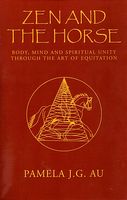 |
Here's what others are saying about Zen and the Horse:
"I think this is the first writing that actually describes what I feel when I ride my horses. I have never wanted to compete, just reach that place of unity which will be an ongoing practice with the horse for the rest of my life. No hurry to get somewhere, only connect while there! Maybe someday you will put this great book into visual movement in a video? You have really taken the mechanics out and replaced with emotion, awareness, with motivation to feel!!! With great respect to our patient teacher, the horse. " Chris in OR.
"I finally got your book in the mail and am in the middle of it -- I wanted to let you know that the way it is written, along with the approach you have to the "art of equitation" speaks to me in a way that no other literature about horses has." Lila W.
"I have just finished reading your book Zen and the Horse. I find it to be incredibly useful. I sit straight and relaxed, breathe deeply, and give thanks for this teacher who can help us to interpret the teaching of our wonderful horses and evolve ourselves." Sarah M.
To order and read excerpts click on
AVAILABLE IN HARDBACK OR PAPERBACK GET YOUR COPY TODAY!
Copyrighted works 1994, 2003. All rights reserved |
Zen horsemanship, a holistic approach, encompasses the mind, body and spirit of horse and rider/owner. Riding a horse is a partnership. The horse cannot perform if his partner hinders the natural motion. A video analysis can help pinpoint areas of discomfort and stress for the horse, help resolve training problems that occur during riding and assist the rider in offering clear communication to his partner. There are four main body postures or expressions while mounted; forceful, unyielding, engulfing and shrunken. (As described in my book, chapter on Body Alignment.) Within these expressions are variations that are determined by the emotional body and attitude of the rider. |
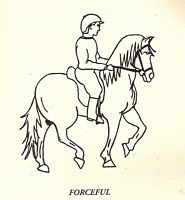 |
Forceful This expression looks forceful. It is not fluid and in harmony with each other. There is a great need to control and challenge instead of working together. The rider's ego is so big, it throws him off balance. He wants everyone to notice him. This type of individual will have difficulty elongating his leg and suppling his seat. It is much easier to use brawn instead of finesse. This rider needs to allow the horse to be his teacher, although humbleness is not in his nature. There is too much fear of losing control. |
Unyielding This rider is immovable in attitude. For improvement to take place a flexible mind is required. There are many insecurities. In efforts to hide this insecurity, the rider clenches the horses and the posture closes. There is restriction in the joints and flexibility of the body as well as the mind. The horse receives mixed messages as he tries to please his rider when he is urged forward but the restrictions in the body posture of the rider doesn't allow forward movement. The result is a frustrated horse and rider. |
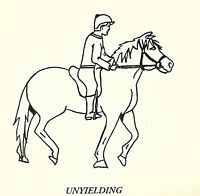 |
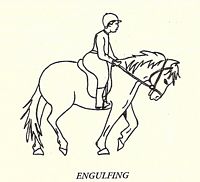 |
Engulfing This body expression represents possessiveness. The emotional attitude is that of smothering. The rider has a need to feel loved and accepted. Everything in their life must be in order and proper. The horse is never allowed to sweat or work too hard for fear of hurting his feelings. The horse takes full advantage and eventually develops many dangerous habits. |
Shrunken This rider needs a backbone. They need to learn to be aggressive. It is very difficult for this rider to ride the horse forward as the collasped abdomen does not allow proper use of the body. The chest is caved in out of protection and fear of being emotionally hurt. There is a lack of self confidence and the horse takes charge. An older well trained, kind horse can help this type of rider develop confidence and inner strength. |
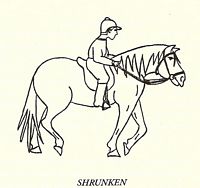 |
All of the rider postures determine the carriage of the horse. The more we as riders work on our position and emotional attitude, riding becomes harmonious. When the proper position is achieved this lifts the abdomen and aligns the spine as well as the chakra centers. With this alignment comes release of stored emotional energies that originally brought on the structural changes. It is a spiritual healing as well as a great ride!!All of the rider postures determine the carriage of the horse. The more we as riders work on our position and emotional attitude, riding becomes harmonious. Copyrighted works 1994, 2003. All rights reserved. |
|
|